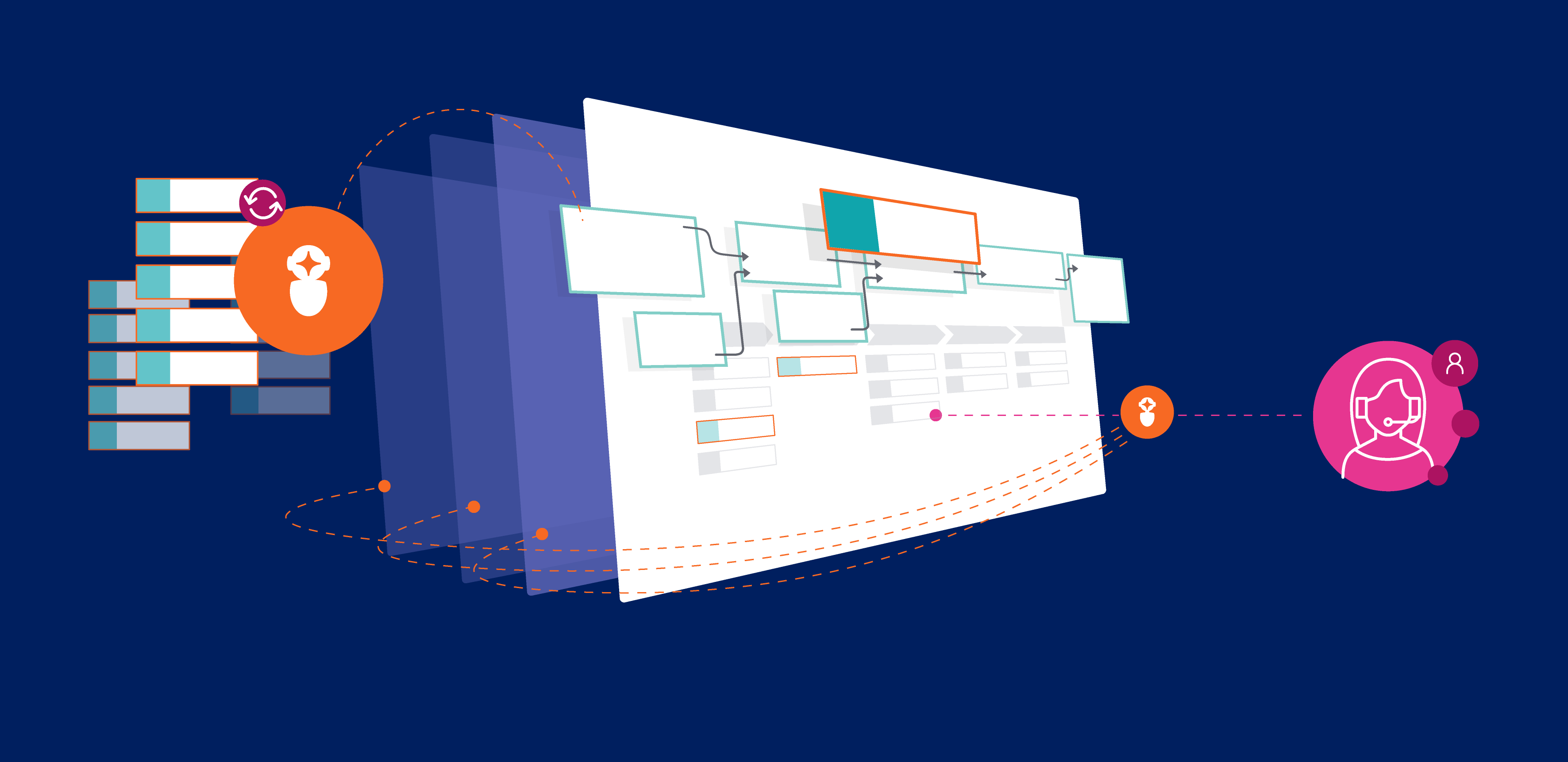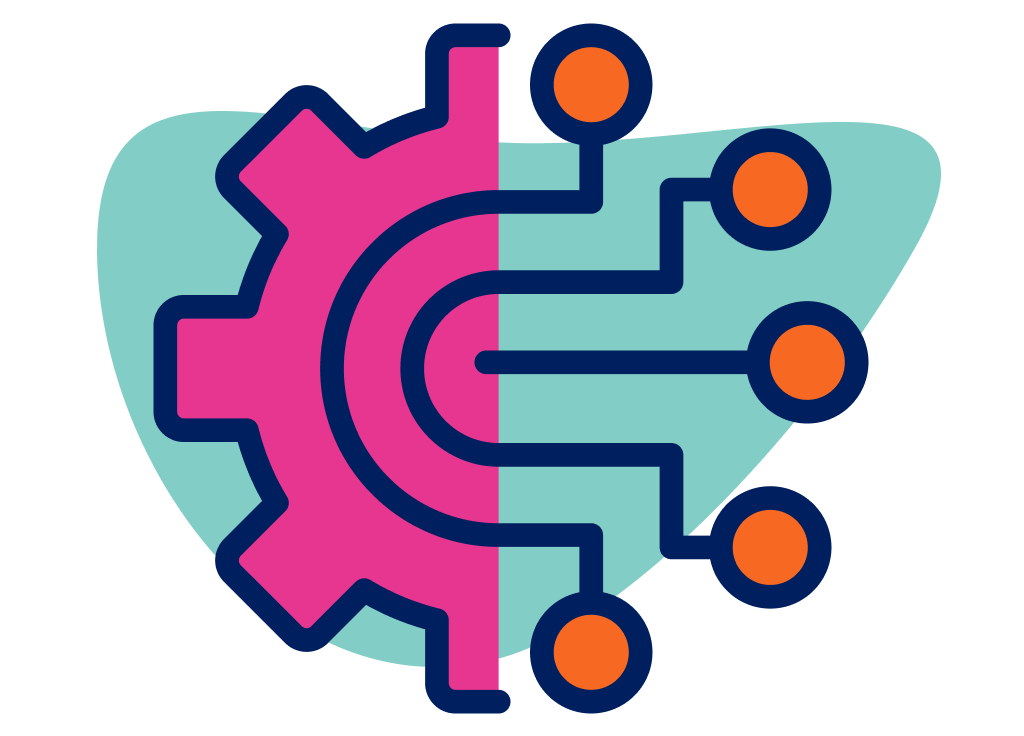
What is robotic process automation?
How software bots automate work to drive productivity and efficiency gains

What is robotic process automation?
Robotic process automation (RPA) is a software-based approach that uses bots to automate tedious, repetitive tasks. This eliminates the need for human intervention, optimizing processes while enabling employees to focus on more important tasks and initiatives.
As a noninvasive technology, RPA equips organizations to:
- Bridge legacy systems
- Easily close integration gaps
- Wrap legacy system integrations without making changes to underlying technology investments

Comparing RPA and AI
Robotic process automation (RPA) and artificial intelligence (AI) are distinct yet complementary technologies. Together, they form a powerful synergy. To break down the differences:
RPA
- Process-driven, excels in automating rule-based tasks
- Mimics human actions to enhance efficiency
- Replicates tasks, focusing on process automation
- Aids AI by automating routine tasks, allowing AI to focus on intricate analysis
AI
- Data-driven, simulates human intelligence
- Utilizes machine learning, natural language processing, and reasoning
- Learns and adapts, emulating cognitive functions
- Enhances RPA by introducing adaptive learning and cognitive capabilities, expanding the potential scope of automation
Why use RPA?
As part of a workflow automation strategy, RPA removes the need for employees to perform repetitive work, enabling work to be processed digitally with greater speed and accuracy.
To do so, RPA automates business processes to accelerate work outcomes, removes opportunities for errors, and enables organizations to scale quickly for spikes in volume without additional resources.
With 24/7 transaction processing capabilities, RPA can also increase productivity and eliminate processing backlogs, reducing costs associated with rework.
Benefits of RPA
- Optimizes resources. By automating routine tasks, employees are free to perform more high-value work. Employees are more efficient and engaged when focusing on decision-making and customer service that needs a human touch.
- Increases productivity. RPA can work on-demand or around the clock. This allows for faster turnaround on work requests and significantly improves SLAs.
- Lowers costs. RPA creates an intelligent software-based workforce that lowers the cost associated with high-volume, repetitive tasks that don’t require human intervention.
- Reduces risk. When processes complete flawlessly every time, you don’t need to allocate additional time or resources for rework. Bots don’t make mistakes or judgement calls, and they never get tired.
- Digitizes legacy apps. When transforming digitally, many IT leaders find that legacy apps create bottlenecks in common enterprise processes and often cannot be digitized quickly through the creation of relevant APIs. RPA provides a way to weave those apps into broader enterprise processes that involve both human and AI elements.


How does RPA work?
RPA provides tools you can use to automate repetitive work so your employees can focus on customers, while bots do the repetitive, rote work. For example, automations you create can bridge gaps between various software applications employees use, eliminating the time spent starting and navigating through those applications. This allows you to integrate legacy systems and avoid silos.


Forrester names Pega a leader in robotic process automation

How RPA is transforming businesses
RPA is catalyzing a transformative wave in business operations, with a pronounced emphasis on software bots. RPA bots execute rule-based tasks tirelessly and with precision, liberating human resources for more strategic initiatives. These bots seamlessly integrate with diverse applications, mirroring human interaction across systems.
The transformative impact of RPA extends to enhanced productivity, operational agility, and cost efficiency. By automating routine processes, RPA not only accelerates workflow but also reduces errors, ensuring a consistent and reliable output. The adoption of RPA heralds a paradigm shift, empowering businesses to navigate a dynamic landscape with a digital workforce that complements and augments human capabilities.
Challenges of RPA
Navigating the transformative landscape of RPA introduces distinct challenges that demand strategic consideration. Top concerns include:
- Organizational culture: The integration of RPA may redefine job roles, reducing the need for certain functions while spawning new and increasingly complex tasks. Successful adoption hinges on cultivating a culture of learning and innovation as responsibilities evolve.
- Difficulty scaling: Scaling can pose challenges due to regulatory shifts and internal modifications. The need to ensure that automated tasks comply with updated standards can slow down the scaling process. Modifications to existing processes or the introduction of new technologies can also disrupt automated workflows, making scaling more difficult.
- Educational investments: Addressing the evolving landscape requires investment in staff education and training programs. These initiatives prepare teams for ongoing shifts in priorities, ensuring adaptability and paving the way for successful outcomes in automation and digital transformation projects.


What’s the difference between attended and unattended RPA?
Attended RPA
With attended RPA, users interact with the automation on their desktop. For example, in a customer service scenario, a typical automation would consist of the following steps:
- The bot runs an automation to retrieve customer information from various applications.
- The bot then presents the information to the service representative.
- The representative can change the customer information as needed.
- The bot runs an automation to update the original application with those changes.
Unattended RPA
With unattended RPA, the work is performed automatically without human intervention. Typical use cases involve automating repetitive back-office tasks, such as when employees submit work to a queue and robots automate the work in batches.
What’s included in RPA?
Attended RPA
Users interact with bots on their desktop, increasing productivity and efficiency
Unattended RPA
Bots perform work automatically without human intervention
Auto-balancing
AI is used to intelligently optimize the capacity and efficiency of unattended bot resources
X-ray vision
Pega’s patented RPA technology enables faster and more accurate automation building
Chatbots and virtual assistants
Channels supporting conversations between employees, bots, and their external contacts
Process mining and task mining
Process and task mining capture actionable insights to drive process optimization

Frequently Asked Questions about robotic process automation

